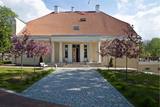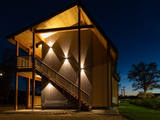| Нo | Название | Описание |
|---|---|---|
|
The tree is in the middle of an untended field. Despite many dead branches and the messy surroundings, the tree is beautiful and well visible from the road. It is the third thickest tree in the Baltic States.
|
||
|
Atrodas galvenās Kuldīgas gājēju ielas malā. Sadarbojas ar vietējiem zemniekiem un piedavā Kurzemes novadam raksturīgus ēdienus, kā arī ēdienus no dažādu pasaules valstu receptēm. |
||
|
Mācību drava "Kāre" piedāvā iepazīties ar bišu valstības noslēpumiem. Interesanta iepazīšanās ar brīnumiem un noslēpumiem bišu saimes dzīvē. Apmeklētājiem ir iespēja ietērpties speciālos aizsargtērpos un bitenieka vadībā iepazīties ar dzīvas bišu saimes smaržu. Veselībai un dzīvespriekam iespējams iegādāties - medu, bišu maizi, bet romantiskai noskaņai - smaržīgas bišu vaska svecītes. |
||
|
Atrodas netālu no Biksēres muižas, blakus muižas parkam. Ozolkalna klēts saimniece Līga Kuba aušanas prasmes pirms pāris gadiem apguvusi Sarkaņu amatu skolā. Šeit radusies iecere par privātas aušanas darbnīcas izveidi, kas arī īstenota. Saimniece savas aušanas prasmes nodod jebkuram interesentam. Apmeklētāji var iegādāties šeit darinātos suvenīrus. |
||
|
Находится к югу от Екабпилса, в северо-восточной части песчано-гравийного карьера Раджу (водохранилище Раджу). Интересно, что камень найден во время разработки карьера. Камень Раджу оценивается как второй по величине валун Латвии (объем ~ 100 м3). В северной части карьера создан Екабпилсский лесопарк – популярнейшее место для прогулок, отдыха и занятий спортом горожан. В 2012 году пляжу водохранилища Раджу присвоен «Голубой флаг». |
||
|
Находится на северо-восточном берегу озера Разнас. Хозяйка предлагает латгальские блюда, интерактивные занятия по изучению окружающей среды и услуги гида. Латышская кухня: Блюда из пресноводной рыбы - копченая рыба, лини в сметанном соусе, жареные в масле окуни, запеченный в духовке лещ, фаршированная щука и другие, приготовленные из местных продуктов блюда. Особое блюдо: Приготовленная на костре Разнасская уха. |
||
|
Atrodas Jūrmalciema austrumdaļā. Koka šķūnī sakrāti vietējo entuziastu savāktie Jūrmalciema iedzīvotāju sadzīves priekšmeti un amata rīki. Novadpētnieki te var uzzināt vērtīgu informāciju par ciema vēsturi un zvejnieku dzīvesveidu. |
||
|
Профессиональный сельскохозяйственный тур с посещением местных фермерских хозяйств, типичных для региона. Мы встретим и познакомимся с вами в Вильнюсе, где проведем обзорную экскурсию по городу. На следующий день отправимся в Каунас на профессиональные встречи и прогулку до городу. На пути в Ригу посетим живописный замок Тракай, расположенный на озере. В Паневежисе нанесем визит профессиональному выращивателю яблок. В Риге вас ждет обзорная экскурсия по Старому Городу, а также посещение впечатляющего Центрального рынка. В Бауске нанесем профессиональный визит на ферму, специализирующуюся на введении инновативных методов фермерства (зерновые культуры, овощи, картофель). На пути из Риги в Таллинн остановимся в городе Сигулда, где посетим средневековый замок Турайду с великолепными панорамными видами на древнюю долину реки Гауя. В Таллинне посетим Старый Город, пройдемся по узким мощеным улочкам, а потом нанесем профессиональный визит на молочную ферму в Саку, встретимся с Эстонским Фермерским Союзом и посетим другую скотоводческую и земледельческую ферму около Таллинна. |
||
|
This is the thickest and tallest common ivy in Latvia. It is in the park of the Zentene Estate, opposite the mansion (which is now a school).
|
||
|
Ja Rušona ezeru iepazīstiet ar laivu, tad var apmeklēt Lielo salu (ezera rietumdaļā),kur (augstākajā vietā) ir jāuzmeklē ap 1,2 m augstais akmens. Konstatēts, ka tā apkārtnē un uz virsmas kurināta uguns. Atrastas arī senlietas. Nostāsti vēsta, ka akmens virsmā bijušas iekaltas zīmes (nav saskatāmas) un pie tā upurēti jēri. Tikai nedodieties ezerā, ja ir vai gaidāms stiprs vējš! Rušona ezera salas ir dabas liegums. |
||
|
Предлагает посмотреть африканских страусов разного возраста, истории о и вокруг страусов. Изделия из страусиного пера, кожи и жира, свежие яйца страусов. |
||
|
Ресторан Kest предложит Вам отправиться в настоящее гастрономическое путешествие. Вот уже более двух десятилетий шеф-повар Марис Янсонс готовит различные блюда, делая одно гастрономическое открытие за другим. |
||
|
Моленная Ульяновской старообрядческой общины осно-
вана в 1875 году. Моленная не богата украшениями и не удивляет
своей архитектурой, но это то место, куда каждый может прийти
и исповедоваться.
|
||
|
В 0,2 км к северо-востоку от Ливского народного дома, с дороги Мазирбе - Кошрагс виднеется «Сеппес». Хозяйственный амбар, имевший в углах бревенчатые соединения впритык, который в 20 - 30 годы прошлого столетия строил пришедший из Самсалы в Мазирбе эстонец - рыбак и плотник Екабс Яга. На другой стороне дороги виднеются «Калши» - жилое строение начала XX века. Восстановлено в наши дни, сохраняя в стенах дома кирпичи, которые обжигались в Брауской кирпичной печи Мазирбе. |
||
|
The restoration of Kau Manor, which was originally constructed before 1241, was inspired by the colourful history of the manor, and the imagination makes it stand out from the other manors. Kau Manor has won the 2016 World Boutique Hotel Award in the category of the World’s Most Inspired Design Hotel. |
||
|
This is certainly the thickest White Willow (Salix alba) in Latvia and perhaps the thickest one in the Baltic States. Many of its mighty branches are resting on the ground, and the enormous monolithic trunk has been split. There’s a small information stand alongside the tree. A pathway which starts at the Raganu cliffs can be taken to the tree.
|
||
|
Это путешествие предлагает вам посетить современные сельские хозяйства, основывающие свою деятельность на древних ремеслах и навыках.
Все, что выращивается и производится в сельской местности Латвии, можно найти на Рижском центральном рынке, поэтому путешествие начинается здесь – на одном из крупнейших и старейших рынков в Европе. Далее по плану – посещение нескольких сельских хозяйств с дегустацией их продукции - конфет из натуральных соков, сыра, блюд из зерновых, йогурта, мороженого. Традиционный крестьянский дом и музей техники. В каждом хозяйстве небольшая ознакомительная экскурсия. В маршрут путешествия включена также архитектурная жемчужина рококо и барокко 18 века архитектора Растрелли - Рундальский дворец с парком и розарием. В Бауске можно осмотреть расположенную в Ратуше коллекцию древних приспособлений для измерения, Бауский замок и Баускую пивоварню. В Литве предусмотрено посещение хозяйств по выращиванию лаванды, лекарственных растений и конопли, где можно будет приобрести их продукцию. Город Аникщяй (Anykščiai) предлагает прогулочную тропу над верхушками деревьев. Археологический комплекс в Кернаве (Kernavė) является объектом наследия ЮНЕСКО. В заключении путешествия – построенный в 14-15 веках Тракайский замок и Вильнюс. |
||
|
Bestes Apartments is a new guest house that can accommodate 45 guests at a time (+ 10 extra beds). The guest house was built and designed in the Latvian style (a wooden building made here in Mūrmuiža), beds made in Latvia, bed linen made in Latvia were used. |
||
|
The farm breeds purebred and crossbred cattle for seed, fattening and meat production. It sells piglets and pork, grows grains and potatoes, and engages in beekeeping. Six ponds are used to breed carp, tench and orfe. During the winter, fishing is possible in special basins that are based on the flooding of a curve in the Bērzene River. Valti offers a look at biological farming, beef cattle breeding, genetic work related to purebred animals, and fishing outdoors. The farm has a special seminar room and kitchen for seminars and training. The farm maintains the Oskars Kalpaks trail, which crosses a territory that is geological and landscape interest. |
||
|
This military object ensured radio communications. Now the facility is owned by the Latvian Defence Ministry, and it can only be viewed from the outside.
|
||




















